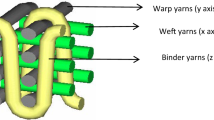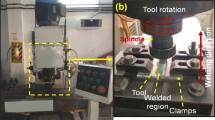Abstract
In this study, the effect of clamping force on the bolted double-lap joints has been investigated experimentally. The mechanical behavior of the present joint has been divided into several stages based on the sequence of failure. The commencement failure occurred in such joint is the sticking failure, i.e., loose of clamping effect. One of the main objectives of present investigation is to study the effect of tightening torque value (T = 0–30 Nm) on the sticking failure load, i.e., initiation of the relative sliding. Three different geometries (e/D = 1, 2, and 3) have been adopted to get different modes of failure, namely bearing, shear, and tensile. A steel sheet AISI 1006 with fixed width 30 mm and thickness 3 mm was used. The present experimental results showed six different stages identifying the mechanical behavior of the double-lap joint namely; sticking failure, bearing failure, shearing failure, ultimate strength, tensile/shear crack initiation (depending on the value of e/D), and lastly final failure. For e/D = 2 and 3, the maximum value of sticking failure load is obtained at T = 25 Nm, while T = 30 Nm for e/D = 1. Furthermore, for all values of e/D, the values of sticking failure load are approximately the same at T = 30 Nm. In the case of small values of tightening torque (T < 25 Nm), the stiffness of the joint before sticking failure increased by increasing the value of e/D and T. The difference between the stiffness of joints with different values of e/D, e/D = 1–3, decreased by increasing the tightening torque.














Similar content being viewed by others
References
Arouche MM, Budhe S, Alves LA, Teixeira de Freitas S, Banea MD, de Barros S (2018) Effect of moisture on the adhesion of CFRP-to-steel bonded joints using peel tests. J Braz Soc Mech Sci Eng 40:10
Agrawal BP, Chauhan AK, Kumar R, Anant R, Kumar S (2017) GTA pulsed current welding of thin sheets of SS304 producing superior quality of joint at high welding speed. J Braz Soc Mech Sci Eng 39:4667–4675
Abid M, Awan AW, Nash DH (2014) Determination of load capacity of a non-gasketed flange joint under combined internal pressure, axial and bending loading for safe strength and sealing. J Braz Soc Mech Sci Eng 36:477–490
El-Sisi AE, Salim H, El-Hussieny OE, Sallam HEM (2014) Behaviors of a cracked lapped joint under mixed mode loading. Eng Fail Anal 36:134–146
Ahn H-S, Kweon J-H, Choi J-H (2005) Failure of unidirectional-woven composite laminated pin-loaded joints. J Reinf Plast Compos 24:735
Aktas A, Imrek H, Cunedioglu Y (2009) Experimental and numerical failure analysis of pinned-joints in composite materials. Compos Struct 89:459–466
Li QM, Mines RAW, Birch RS (2001) Static and dynamic behavior of composite riveted joints in tension. Int J Mech Sci 43:1591–1610
Hoang TD, Herbelot C, Imad A (2012) On failure mode analysis in a bolted single lap joint under tension-shearing. Eng Fail Anal 24:9–25
Hoang TD, Herbelot C, Imad A (2010) Rupture and damage mechanism analysis of a bolted assembly using coupling techniques between A.E. and D.I.C. Eng Struct 32:2793–2803
Hoang TD, Herbelot C, Imad A, Benseddiq N (2013) Numerical modeling for prediction of ductile fracture of bolted structure under tension shear loading. Finite Elem Anal Des 67:56–65
Salim H, El-Sisi AE, El-Emam H, Sallam HEM (2016). Maximum clamping force in single and double lapped joints. American Society for composites 31st technical conference & ASTM committee D30 meeting September 19–22, Virginia, USA
Khashaba UA, Sallam HEM, Al-Shorbagy AE, Seif MA (2006) Effect of washer size and tightening torque on the performance of bolted joints in composite structures. Compos Struct 73:310–317
Esmaeili F, Zehsaz M, Chakherlou TN (2014) Investigation the effect of tightening torque on the fatigue strength of double lap simple bolted and hybrid (bolted–bonded) joints using volumetric method. Mater Des 63:349–359
El-Sisi AE, El-Emam H, Salim H, Sallam HEM, El-Hussieny OM (2016) Behavior of single and double bolted staggered joint in thick composite plates. American Society for composites 31st technical conference & ASTM committee D30 meeting September 19–22, Virginia, USA
Mínguez JM, Vogwell J (2006) Effect of torque tightening on the fatigue strength of bolted joints. Eng Fail Anal 13:1410–1421
Chakherlou TN, Abazadeh B, Vogwell J (2009) The effect of bolt clamping force on the fracture strength and the stress intensity factor of a plate containing a fastener hole with edge cracks. Eng Fail Anal 16:242–253
Minguez JM, Vogwell J (2006) Effect of torque tightening on the fatigue strength of bolted joints. Eng Fail Anal 13:1410–1421
Chakherlou TN, Abazadeh B, Vogwell J (2009) The effect of bolt clamping force on the fracture strength and the stress intensity factor of a plate containing a fastener hole with edge cracks. Eng Fail Anal 16:242–253
Sallam HEM, El-Sisi AEA, Matar EB, El-Hussieny OM (2011) Effect of clamping force and friction coefficient on stress intensity factor of cracked lapped joints. Eng Fail Anal 18:1550–1558
Sallam HEM, Abd El-Aziz Kh, Abd El-Raouf H, Elbanna EM (2013) Failure analysis and flexural behavior of high chromium white cast iron and AISI4140 steel bimetal beams. Mater Des 52:974–980
Abd-Elhady AA, Sallam HEDM (2015) Crack sensitivity of bolted metallic and polymeric joints. Eng Fract Mech 147:55–71
Ghanem M, Al-Shorbagy AE, Khashaba UA, Sallam HEM (2006) Mechanical behavior and failure mode of bolted joints in polymeric composite materials. In: 4th Assiut University international conference on mechanical engineering advanced technical and for industrial production, December 12–14, Assiut, Egypt
Sallam H, Abd-Elhady A (2015) Prediction of crack initiation site in fastener hole of composite laminate. Advanced composites for aerospace, marine, and land applications II. In: Proceedings of a symposium sponsored by The Minerals, Metals & Materials Society (TMS), 144th annual meeting and exhibition, March 15–19, Walt Disney World, Orlando, Florida, USA
BS EN ISO 898-1:2013. Mechanical properties of fasteners made of carbon steel and alloy steel- Partr1: bolts, crews, and studs with specified property classes—coarse thread and fine pitch thread
Barrett RT (1990) Fastener design manual. NASA reference publication 1228 (1990). https://ntrs.nasa.gov/archive/nasa/casi.ntrs.nasa.gov/19900009424.pdf
Jones FD, Ryffel HH, McCauley CJ, Green RE, Heald RM (2004) Machinery's handbook, 27th edn. Industrial Press Inc, New York
Khurmi RS, Gupta JK (2005) Textbook of machine design (S.I units), 5th edn. Eurasia Publishing House (PVT.) LTD, New Delhi
Mınguez JM, Vogwell J (2006) Effect of torque tightening on the fatigue strength of bolted joints. Eng Fail Anal 13:1410–1421
Cooper C, Turvey GJ (1995) Effects of joint geometry and bolt torque on the structural performance of single bolt tension joints in pultruded GRP sheet material. Compos Struct 32:217–226
Author information
Authors and Affiliations
Corresponding author
Additional information
Technical Editor: Eduardo Alberto Fancello.
Rights and permissions
About this article
Cite this article
Abu-Sinna, A., Abd-Elhady, A.A., Atta, M. et al. The failure stages of bolted double-lap metallic joints: experimental study. J Braz. Soc. Mech. Sci. Eng. 40, 388 (2018). https://doi.org/10.1007/s40430-018-1314-2
Received:
Accepted:
Published:
DOI: https://doi.org/10.1007/s40430-018-1314-2




